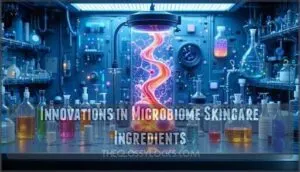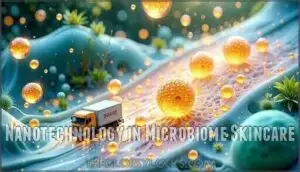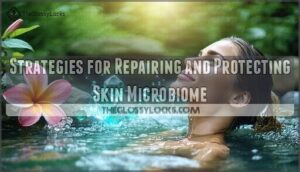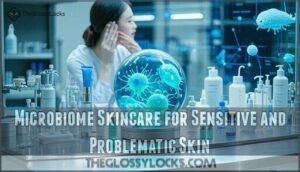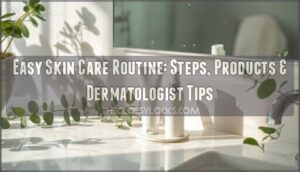This site is supported by our readers. We may earn a commission, at no cost to you, if you purchase through links.
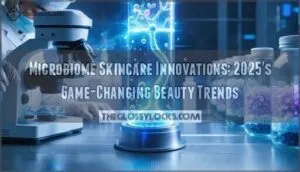
Advanced probiotics deliver live bacteria directly to problem areas, while prebiotics feed your skin’s existing good guys. Companies like Glacies Biome use AI-powered sequencing to create tailored treatments that match your unique bacterial fingerprint.
The market’s projected to hit $835.2 million by 2030, driven by engineered probiotics that target specific conditions like eczema with surgical precision. The secret lies in understanding which bacterial strains your skin craves most.
Table Of Contents
- Key Takeaways
- Skin Microbiome: Foundation of Healthy Skin
- Innovations in Microbiome Skincare Ingredients
- Breakthrough Formulations and Delivery Methods
- Market Trends and Leading Microbiome Skincare Brands
- Building and Maintaining a Balanced Skin Microbiome
- Frequently Asked Questions (FAQs)
- Is a microbiome infused skincare product right for your skin?
- Are microbiome cosmetics reshaping aging skin?
- Why is microbiome skin care important?
- What is skin microbiome?
- Are microbiome cosmetics effective for sensitive skin management?
- What are the best microbiome skin care brands?
- What is the microbiome technology in skincare?
- What is good for skin microbiome?
- How do you build skin microbiome?
- How do you repair skin microbiome?
- Conclusion
Key Takeaways
- You’ll discover that microbiome skincare uses AI-powered sequencing to create personalized treatments based on your unique bacterial fingerprint, moving beyond one-size-fits-all approaches to target your specific skin concerns with engineered probiotics.
- Your skin hosts trillions of beneficial microorganisms that act as your personal security team—these microscopic allies defend against harmful pathogens, regulate inflammation, and maintain your protective barrier when properly supported.
- You can now access advanced delivery systems that protect live probiotics through encapsulation technology and nanotechnology, ensuring beneficial bacteria survive until they reach your skin’s surface where they’re needed most.
- You’re witnessing explosive market growth as the microbiome cosmetics sector rockets from $405.6 million in 2023 to a projected $835.2 million by 2030, driven by proven clinical results in treating conditions like eczema and acne.
Skin Microbiome: Foundation of Healthy Skin
Your skin’s natural ecosystem houses trillions of beneficial bacteria, fungi, and other microorganisms that work together to maintain your skin’s protective barrier and immune function.
Think of these microscopic residents as your skin’s personal security team—they defend against harmful pathogens, regulate inflammation, and keep your complexion balanced and healthy.
Microbial Communities and Skin Health
Your skin’s cutaneous ecosystem is home to trillions of microorganisms working as your body’s first line of defense. These microbial communities include bacteria, fungi, viruses, and other microbes that maintain your skin barrier function while protecting against harmful pathogens.
This delicate microbiome balance directly influences your dermatological health through complex interactions. Think of it like a bustling city—one million microorganisms per square centimeter of skin create microbial diversity that keeps your skin healthy. Understanding the skin microbiome composition is essential for maintaining healthy skin.
Environmental Impacts on Skin Microbiome
Modern life bombards your microbiome with challenges daily. Air Pollution disrupts beneficial microbiota, while Climate Change intensifies UV Radiation exposure. Toxic Chemicals from skincare products can disturb your environment’s delicate balance. Microplastic Effects are emerging as a concern, though research continues.
These environmental exposures alter your human microbiome composition, potentially triggering skin conditions. Think of it as your microbial community under siege—protecting it requires understanding these invisible threats to maintain healthy skin.
Skin Microbiome and Immune Function
Beyond environmental threats, your microbiome acts as your skin’s personal bodyguard. This complex network orchestrates immune responses through intricate cellular interactions, maintaining microbial balance that strengthens your skin barrier. When your microbiota communicates with immune cells, it regulates inflammatory pathways and prevents harmful pathogens from taking hold.
- Microbial sentries: Beneficial bacteria train your immune system to distinguish between friends and foes
- Barrier reinforcement: Healthy microbiome produces antimicrobial peptides that fortify skin defenses
- Inflammation control: Balanced microbiota prevents overactive immune responses that damage skin
- Cross-talk benefits: Your gut microbiome influences skin immunity through systemic immune modulation
Innovations in Microbiome Skincare Ingredients
You’ll discover that today’s microbiome skincare ingredients go far beyond basic probiotics, with scientists now engineering live bacteria that deliver targeted proteins directly to your skin cells. These pioneering formulations include prebiotics that feed beneficial microbes, postbiotics that provide instant barrier repair, and synthetic biology innovations that treat specific conditions like eczema with precision you couldn’t imagine just five years ago.
Probiotics, Prebiotics, and Postbiotics Explained
Understanding how probiotics, prebiotics, and postbiotics work transforms your skincare routine. Probiotics are live bacteria that restore microbiome balance when applied topically. Prebiotics feed beneficial skin microbiota, while postbiotics deliver metabolites that support barrier function and reduce inflammation through the gut-skin axis.
| Component | Function |
|---|---|
| Probiotics | Live bacteria restoring skin microbiome |
| Prebiotics | Nutrients feeding beneficial microbes |
| Postbiotics | Bacterial metabolites reducing inflammation |
| Microbiome Balance | Ideal bacterial ecosystem health |
| Gut-Skin Axis | Connection between digestive and skin health |
Engineered Probiotics and Live Biotherapeutics
Scientists have revolutionized therapeutic probiotics by engineering specific strains to target skin conditions. Live Biotherapeutics represent advanced microbial therapy that repairs your skin barrier through precise bacterial modifications. These therapeutic probiotics work differently than gut bacteria, delivering antimicrobials directly where needed.
- Enhanced Cutibacterium acnes strains reduce inflammation and improve skin repair
- Engineered Staphylococcus epidermidis targets MRSA using quorum-sensing pathways
- Modified probiotics increase ceramide production for better moisture retention
- Live biotherapeutics show clinical improvements in acne and atopic dermatitis
Further research on tumor antigen responses highlights the potential of engineered bacteria in treating various conditions.
Synthetic Biology and Targeted Microbial Therapies
Genetic engineering revolutionizes skincare through synthetic microbes that act like microscopic doctors. Bioengineered skincare now features targeted probiotics programmed to deliver anti-inflammatory compounds directly to problem areas.
Scientists now engineer microscopic doctors that deliver targeted anti-inflammatory treatments directly to your skin’s problem areas
These microbial therapeutics respond to your skin’s pH and inflammation markers, releasing treatments on-demand. Microbiologists create synthetic microbes that convert sweat into beneficial compounds, offering precision therapy beyond traditional gut microbiome research applications.
Breakthrough Formulations and Delivery Methods
You’ll find that modern delivery systems now protect beneficial microbes through sophisticated encapsulation technology, ensuring they survive until they reach your skin’s surface.
These pioneering formulations use nanotechnology and specialized carriers to deliver live probiotics exactly where your microbiome needs support most.
Topical Applications and Product Types
What happens when you bring microbiome science directly to your bathroom shelf? Topical microbiome products now include creams, serums, and cleansers that target specific skin concerns . These cosmetic formulations work differently than traditional skincare by supporting your skin’s natural ecosystem.
- Microbiome serums deliver concentrated probiotics to rebuild skin barriers damaged by environmental stress
- Probiotic creams provide sustained release of beneficial microbes while moisturizing
- Topical prebiotics feed existing good bacteria, strengthening your skin’s natural defense system
Nanotechnology in Microbiome Skincare
While nanoparticle delivery systems modernize microbiome skincare, these tiny carriers transport bioactive compounds directly through your skin barrier.
Nanoformulations enable targeted microbe interactions, delivering probiotics where they’re needed most.
Sophisticated microbiome research shows these systems boost beneficial microbes while protecting your skin’s natural ecosystem. Think of nanoparticles as microscopic delivery trucks for your microbiomes.
Ensuring Probiotic Viability in Products
Microbiologists know that probiotic stability often determines whether your skincare delivers promised benefits. Your microbiome needs living microbes to thrive, but keeping them viable presents unique challenges:
- Microbe Encapsulation – Protects beneficial bacteria from harsh ingredients
- Viability Testing – Ensures cell counts remain therapeutic throughout product shelf life
- Fermentation Methods – Controls pH and creates ideal environments
- Product Shelf Life – Balances preservation with microbiome research findings
Market Trends and Leading Microbiome Skincare Brands
You’re witnessing a notable shift in skincare as the global microbiome cosmetics market rockets from $405.6 million in 2023 to a projected $835.2 million by 2030.
Companies like Glacies Biome now use AI-powered sequencing to create customized treatments based on your unique facial microbiome, while verified microbiome-friendly labels help you navigate this science-backed beauty revolution.
Growth of Microbiome Cosmetics Market
You’re witnessing explosive growth in microbiome cosmetics. Market trends show the sector will reach $2.26 billion by 2025, driven by consumer demand for tailored skincare solutions.
Product development now focuses on gut microbiome research and microbial ecology insights. Investment opportunities are flourishing as regulatory frameworks evolve to support microbiome research applications.
Verified Microbiome-Friendly Labels
With explosive market growth comes the need for trust. You’re no longer shooting in the dark when choosing microbiome-friendly products. Independent certification guarantees the Microbiome-friendliness of your products and provides full legal protection, while microbiologists develop standardized microbiome testing protocols to verify claims.
Key label verification benefits:
- Confidence in product safety for your skin’s microbial ecology
- Protection from misleading marketing claims
- Access to clinically-tested, sustainable packaging options
Pioneering Brands and Product Innovations
Companies like Glacies Biome and BYOME LABS lead with AI-driven skin analysis and microbiome testing. You’ll find custom products from these microbiologists who create probiotic formulas based on your unique microbes.
Skinome partnered with BioGaia for live-bacteria concentrates, while ResVita Bio engineers therapeutic bacteria.
These cosmetic innovations target your specific microbiome needs through sophisticated testing.
Building and Maintaining a Balanced Skin Microbiome
You can’t maintain healthy skin without supporting the trillions of microorganisms that call your face home—think of them as your skin’s personal security team that works 24/7 to keep irritants and harmful bacteria at bay.
Building this microbial balance requires strategic daily habits, from choosing gentle cleansers that won’t strip your skin’s protective barrier to incorporating prebiotic-rich products that feed your beneficial bacteria.
Strategies for Repairing and Protecting Skin Microbiome
You can rebuild your microbiome through targeted Probiotic Therapy and gentle cleansing routines that preserve your Skin Barrier.
Microbiome research shows that tailored Skincare approaches, including selective Microbe Transplant techniques, help restore microbial balance after disruption.
Avoid harsh products that strip beneficial microbes—your skin’s ecosystem needs nurturing, not nuclear warfare.
Role of Diet and Lifestyle in Skin Health
Your diet quality directly impacts your skin’s microbiome balance. Poor nutrition choices trigger gut microbiome disruption, leading to systemic inflammation that shows up on your face. Here’s how lifestyle choices affect your skin nutrition:
- Western diets high in sugar and processed foods reduce beneficial microbes and promote acne-causing bacteria
- Fiber-rich foods feed good gut bacteria that produce skin-protecting compounds and strengthen barrier function
- Probiotic foods like yogurt and kimchi help restore microbial balance and reduce inflammatory skin conditions
- Antioxidant-rich diets with omega-3s correlate with enhanced skin health and reduced dermatitis risk
Your digestion affects your complexion more than you’d think.
Microbiome Skincare for Sensitive and Problematic Skin
When sensitive skin meets dysbiosis, your skin barrier becomes a battlefield. Microbiome testing reveals which microbiomes need backup, guiding tailored skincare strategies.
Probiotic therapy can calm inflammation by restoring beneficial bacteria that support your immune system. Think of it as sending reinforcements to tired skin soldiers—gentle formulations work better than harsh treatments for sensitive skin conditions.
Frequently Asked Questions (FAQs)
Is a microbiome infused skincare product right for your skin?
Your skin’s unique microbiome determines if these products work for you. Consider your skin type, existing conditions, and sensitivity levels before trying microbiome-infused formulas.
Are microbiome cosmetics reshaping aging skin?
Like medieval alchemists seeking youth’s elixir, you’re witnessing engineered probiotics transform aging processes.
Clinical studies show biotech platforms now personalize treatments using facial microbiome data, targeting unique aging signs with precision previously impossible in traditional cosmetics.
Why is microbiome skin care important?
Your body’s bacterial ecosystem directly influences how well your skin functions as a protective barrier. When balanced, these microscopic allies fight inflammation, prevent infections, and maintain ideal pH levels for healthier-looking skin.
What is skin microbiome?
Trillions of microscopic organisms colonize your skin’s surface, creating a bustling ecosystem that’s absolutely mind-blowing! You’re hosting bacteria, fungi, and viruses that naturally protect against harmful pathogens while maintaining your skin’s delicate pH balance and barrier function.
Are microbiome cosmetics effective for sensitive skin management?
Emerging evidence shows you’ll find microbiome cosmetics increasingly effective for sensitive skin management.
Clinical studies show a 25% increase in effectiveness compared to traditional treatments, particularly for restoring your skin’s natural bacterial balance.
What are the best microbiome skin care brands?
Good things come to those who research. Top microbiome brands include Codex Beauty for inflammation management, Esse Skincare for restoration, Tula Skincare, and Aveeno, plus Beekman 1802’s certified microbiome-friendly lineup. Choose based on your specific needs.
What is the microbiome technology in skincare?
Microbiome technology uses AI-powered tests to analyze your skin’s unique bacterial communities, then creates customized treatments with prebiotics, probiotics, and postbiotics to restore balance and target specific concerns.
What is good for skin microbiome?
Like tending a thriving garden, nurturing your skin’s bacterial ecosystem requires balance. Gentle, pH-balanced cleansers preserve beneficial bacteria, while prebiotics and probiotics support diversity.
Use gentle, pH-balanced skincare, avoid harsh chemicals to maintain your skin’s protective microbial community naturally.
How do you build skin microbiome?
You’ll rebuild your skin’s bacterial community through consistent gentle cleansing, eating fermented foods like kimchi and kefir, avoiding harsh products with alcohol or sulfates, and using prebiotic skincare ingredients.
How do you repair skin microbiome?
You’ll repair damaged skin barriers by using gentle prebiotics and probiotics. Avoid harsh chemicals that strip beneficial bacteria.
Focus on pH-balanced cleansers, microbiome-friendly moisturizers, and stress management—your skin’s ecosystem needs consistent nurturing.
Conclusion
Like a master gardener nurturing a thriving ecosystem, you’re now equipped to cultivate your skin’s microscopic community through microbiome skincare innovations. These advanced treatments work synergistically with your natural bacterial allies, offering tailored solutions that traditional skincare couldn’t achieve.
You’ll find engineered probiotics targeting specific concerns while prebiotics nourish existing beneficial strains. The science is clear: supporting your skin’s microbiome isn’t just trendy—it’s transformational for long-term skin health.
- https://www.startus-insights.com/innovators-guide/microbiome-cosmetic-products/
- https://freeyourself.com/blogs/news/microbiome-skincare-market-trends
- https://journals.plos.org/plosbiology/article?id=10.1371/journal.pbio.1002533
- https://www.ncbi.nlm.nih.gov/pmc/articles/PMC4290017/
- https://pubmed.ncbi.nlm.nih.gov/40760050/

